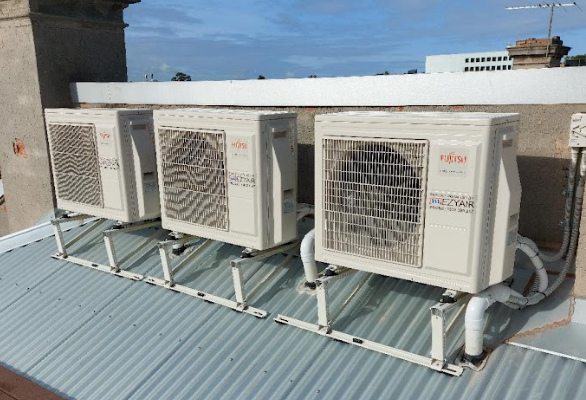What is a defrost mode and how does it work?


What is a defrost mode and how does it work?
Defrost mode is a critical function that enables reverse cycle air conditioners to operate in cold conditions, ensuring they run efficiently, reliably, and with a longer lifespan by preventing ice buildup on the outdoor unit.
The Process Leading to Defrost Mode
-
Formation of Ice:
-
Low Temperatures: When the air conditioner operates in heating mode during cold weather, the outdoor unit can become very cold. The moisture in the outside air can condense on the cold coils and freeze, forming a layer of ice.
-
Humidity: High humidity levels can accelerate the formation of ice on the coils.
-
Low Temperatures: When the air conditioner operates in heating mode during cold weather, the outdoor unit can become very cold. The moisture in the outside air can condense on the cold coils and freeze, forming a layer of ice.
-
Impact of Ice Buildup:
- Reduced Heat Exchange: Ice acts as an insulator, reducing the ability of the coils to exchange heat effectively. This makes the system less efficient.
- Increased Strain: The compressor and other components have to work harder to maintain the desired temperature, leading to potential wear and tear and increased energy consumption.
- Blocked Airflow: Ice can obstruct the airflow through the coils, further diminishing efficiency and potentially causing the system to overheat or shut down.
How Defrost Mode Works
-
Activation:
- The air conditioner is equipped with sensors that monitor the temperature and frost levels on the coils. When these sensors detect that ice has formed, they trigger the defrost mode.
- The air conditioner is equipped with sensors that monitor the temperature and frost levels on the coils. When these sensors detect that ice has formed, they trigger the defrost mode.
-
Reversal of Operation:
- The system temporarily reverses its operation. Instead of extracting heat from the indoor air and releasing it outside (heating mode), it switches to a cooling mode for the outdoor unit.
- Heat Transfer: This reversal causes hot refrigerant to flow through the outdoor coils, melting the ice.
Benefits of Defrost Mode
- Maintains Efficiency: By removing ice buildup, the defrost mode ensures that the heat exchanger operates efficiently, allowing the air conditioner to maintain the desired indoor temperature with less effort.
- Extends Lifespan: Preventing ice buildup reduces the strain on components, thereby extending the lifespan of the system.
- Prevents Damage: Regular defrost cycles prevent potential damage caused by excessive ice, which can lead to costly repairs or system failure.
In summary, defrost mode is a critical function in air conditioners that operate in cold conditions, ensuring they run efficiently, reliably, and with a longer lifespan by preventing ice buildup on the outdoor unit.
How may times will an air conditioner go into defrost mode?
The frequency with which an air conditioner goes into defrost mode can vary widely depending on several factors, including the ambient temperature, humidity levels, the specific model of the air conditioner, and how the system is used. Here’s a breakdown of what influences the defrost cycle frequency:
Influencing Factors
-
Ambient Temperature:
- Colder Temperatures: In colder conditions, the outdoor unit is more likely to accumulate ice, necessitating more frequent defrost cycles.
-
Milder Temperatures: In milder conditions, defrost cycles may be less frequent.
-
Humidity Levels:
- High Humidity: More moisture in the air can lead to quicker ice buildup on the coils, triggering more frequent defrost cycles.
-
Low Humidity: With less moisture in the air, ice accumulation is slower, resulting in fewer defrost cycles.
-
Air Conditioner Model and Design:
- Modern Systems: Newer models often have more efficient defrost mechanisms and advanced sensors that optimise the defrost cycle frequency.
- Older Systems: Older models might have less efficient defrost systems, potentially requiring more frequent cycles.
Typical Frequency
-
General Range: On average, an air conditioner might enter defrost mode every 30 to 90 minutes during operation in cold weather. However, this can vary significantly.
-
Shorter Intervals: In extremely cold or humid conditions, defrost cycles could be as frequent as every 20-30 minutes.
- Longer Intervals: In more moderate conditions, the system might only need to defrost every few hours.
Summary
The frequency with which an air conditioner goes into defrost mode is influenced by external environmental conditions, the specific design of the air conditioning system, and its usage.
While a general estimate might be every 30 to 90 minutes in cold weather, this can vary depending on temperatures. Modern systems are designed to optimise defrost cycles to maintain efficiency and prevent ice buildup effectively.

